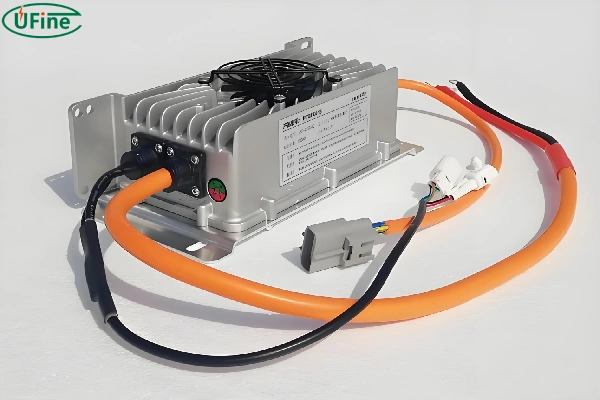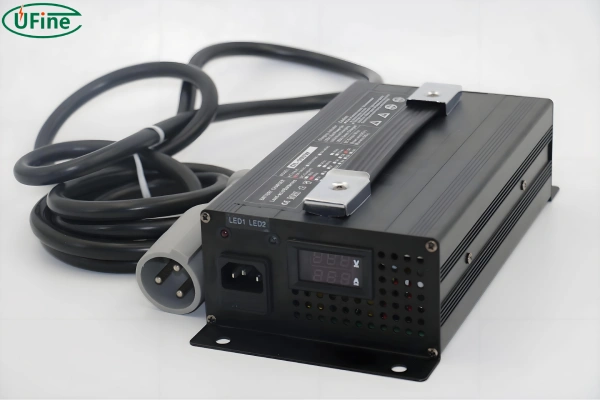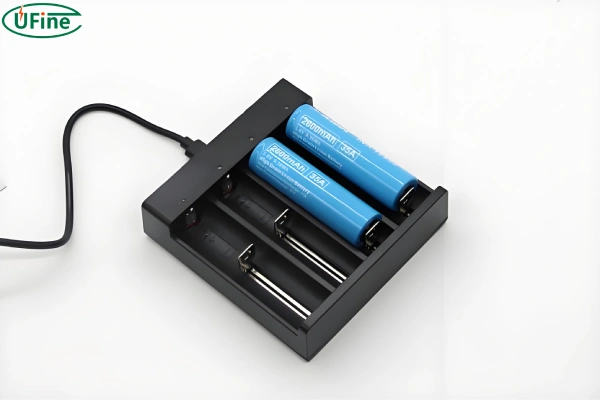In our increasingly mobile and energy-reliant world, deep cycle batteries have become essential. They power everything from RVs and boats to solar energy systems. However, to keep these batteries performing at their best, a specialized tool is required: the deep cycle battery charger. In this comprehensive guide, we’ll dive into what a deep cycle battery charger is, its structure, and the various types available. We’ll also cover the steps to charge a deep cycle battery, how to choose the right charger, and essential maintenance tips. Finally, we’ll discuss whether using a normal charger is a viable option for deep cycle batteries.
Part 1. What is the deep cycle battery charger?

A deep cycle battery charger is a device designed specifically to charge deep cycle batteries. Unlike regular car batteries, deep cycle batteries are built to deliver a steady amount of power over a long period, making them ideal for applications such as marine equipment, recreational vehicles (RVs), and solar power systems. These chargers are engineered to deliver a slow, consistent charge that helps maintain the health and longevity of deep cycle batteries.
Deep cycle batteries undergo deep discharges and require a charger that can replenish them efficiently without causing damage. Regular chargers often fail to provide the specific charging profile needed, potentially shortening the battery’s lifespan. Deep cycle battery chargers are tailored to manage the unique charging needs of these batteries, ensuring optimal performance and durability.
Part 2. Deep cycle battery charger structure
Understanding the structure of a deep cycle battery charger can help you appreciate its functionality. Here are the main components:
- Power Supply Unit: This part converts the alternating current (AC) from your wall outlet into the direct current (DC) needed to charge the battery. It ensures the charger delivers the correct voltage and current.
- Control Circuit: The control circuit regulates the charging process. It monitors the battery’s state and adjusts the charging parameters to ensure the battery is charged safely and efficiently.
- Charging Cables: These are essential for connecting the charger to the battery. They typically include clamps or rings that attach securely to the battery terminals.
- Display/Indicators: Many chargers feature LED displays or indicator lights that show the charging status, battery level, and any error messages. This feedback is crucial for monitoring the charging process.
- Cooling System: To prevent overheating during the charging process, a cooling system (often a fan or heat sinks) is included. Overheating can damage both the charger and the battery, so this component is vital for safety and longevity.
Part 3. Deep cycle battery charging process and characteristics
Charging them correctly is crucial for maximizing their lifespan and performance.
Charging process
- Charging Stages: Deep cycle batteries typically go through several charging stages:
- Bulk Stage: The charger delivers maximum current to bring the battery up to a certain voltage level (around 80% charged).
- Absorption Stage: The charger reduces the current and holds the voltage constant to allow the battery to fully charge.
- Float Stage: After the battery is fully charged, the charger reduces the voltage to a maintenance level to prevent overcharging and keep the battery topped off.
Charging characteristics
- Charging Rate: Deep cycle batteries should ideally be charged at a lower rate (typically 10-15% of their amp-hour capacity) to minimize heat buildup and prolong battery life. For example, a 100Ah battery should be charged at around 10-15 amps.
- Charging Time: Charging time depends on the battery’s capacity, depth of discharge, and charging rate. It can take several hours to fully charge a deep cycle battery.
- Equalization: Some deep cycle batteries benefit from occasional equalization, which involves applying a higher voltage to remove sulfation and balance the cells.
- Temperature: Battery temperature can affect the charging process. It’s best to charge batteries in a cool, well-ventilated area.
Part 4. Understand the status of deep cycle battery chargers
Charging Indicators: Most smart chargers have LED indicators that show the charging status (e.g., charging, charged, fault).
- Voltage Display: Some chargers display the battery voltage during charging.
- Error Codes: If there is a problem with the charging process, the charger may display an error code. Refer to the charger’s manual for information about error codes.
- Float Mode: Once the battery is fully charged, the charger will typically switch to float mode to maintain the charge.
Part 5. Types of deep cycle battery chargers
There are several types of deep cycle battery chargers, each with its own features and benefits. Here’s a closer look at the main types:
- Manual Chargers: These require the user to monitor the charging process and make adjustments as needed. They are generally simpler and less expensive but carry a higher risk of overcharging the battery if not monitored closely.
- Automatic Chargers: These chargers automatically adjust the charging rate and shut off when the battery is fully charged. They are more user-friendly and can prevent overcharging, making them a safer option for most users.
- Smart Chargers: These use advanced algorithms to provide the most efficient charge possible. They can adjust the charging parameters based on the battery’s condition and usage patterns. Smart chargers often come with additional features like battery diagnostics and maintenance modes.
Comparison:
- Manual Chargers: Simple and cost-effective, but require constant monitoring to prevent overcharging.
- Automatic Chargers: Convenient and safer, as they automatically adjust the charging process and shut off when done.
- Smart Chargers: Offer the best battery care with advanced technology but are usually more expensive. They are ideal for those who want to ensure their batteries are always in peak condition.
Part 6. What kind of charger is needed for deep cycle batteries?
Smart Charger: A smart charger is highly recommended for deep cycle batteries. These chargers have multiple stages and can automatically adjust the charging process based on the battery’s condition.
- Voltage Compatibility: The charger must be compatible with the voltage of your deep cycle battery (e.g., 12V, 24V).
- Ampere Rating: The charger should have an ampere rating that is appropriate for your battery’s capacity.
- Battery Type Selection: Many smart chargers allow you to select the type of deep cycle battery you are charging (e.g., flooded, gel, AGM) to optimize the charging process.
- Safety Features: Look for chargers with safety features like reverse polarity protection, overcharge protection, and short circuit protection.
Part 7. How to charge a beep cycle battery?
Charging a deep cycle battery correctly is crucial for its longevity and performance. Here are the steps to follow:
- Safety First: Before you begin, make sure you are in a well-ventilated area and are wearing protective gear such as gloves and safety glasses.
- Inspect the Battery: Check the battery for any visible damage or leaks. If you find any, do not proceed with charging, as it could be dangerous.
- Connect the Charger: Attach the charger’s cables to the battery terminals. Connect the positive cable (usually red) to the positive terminal and the negative cable (usually black) to the negative terminal.
- Select the Charging Mode: Set your charger to the appropriate mode for your battery type. Many chargers have different settings for AGM, gel, or flooded batteries.
- Begin Charging: Plug in the charger and turn it on. If it’s an automatic or smart charger, it will begin the charging process and adjust as needed.
- Monitor the Process: Keep an eye on the charger’s display or indicator lights to track the progress. Make sure the battery does not overheat.
- Completion: Once the battery is fully charged, the charger should either shut off automatically or indicate that the charging is complete. You’ll need to turn the manual chargers off yourself.
- Disconnect Safely: Turn off and unplug the charger before removing the cables. Disconnect the negative cable first, followed by the positive cable.
Charging a deep cycle battery with the right charger ensures safe and efficient recharging, maintaining the battery’s health over time.
Part 8. How to choose a deep cycle battery charger?
Selecting the right deep cycle battery charger involves considering several factors:
- Battery Type Compatibility: Ensure that the charger is compatible with your specific battery type (AGM, gel, flooded, etc.). Using an incompatible charger can damage your battery.
- Amperage: Choose a charger with the appropriate amperage for your battery’s capacity. A charger that is too powerful can cause overheating, while one that is too weak may not charge the battery fully.
- Features: Look for features such as automatic shutoff, multi-stage charging, and safety protections. These features enhance the efficiency and safety of the charging process.
- Portability: If you need to move the charger frequently, consider its size and weight. Portable chargers are convenient for use in different locations.
- Brand and Reviews: Opt for reputable brands known for reliability and quality. Reading user reviews can provide insights into the performance and durability of the charger.
- Price: Consider your budget, but remember that sometimes spending a little more on a high-quality charger can save you money in the long run by extending the life of your batteries.
Part 9. Deep cycle battery charger maintenance tips
Maintaining your deep cycle battery charger is essential for its longevity and effectiveness. Here are some tips to keep it in good condition:
- Regular Cleaning: Keep the charger clean and free from dust and debris. Wipe it down with a dry cloth periodically.
- Check Cables: Inspect the charging cables for any signs of wear and tear. Replace them if they are frayed or damaged to avoid safety hazards.
- Cool Environment: Store the charger in a cool, dry place. Excessive heat can damage the internal components, reducing the charger’s lifespan.
- Firmware Updates: If your charger has smart features, ensure it’s updated with the latest firmware. This helps maintain optimal performance and add new functionalities.
- Routine Inspections: Regularly check the charger for any signs of damage or malfunction. Address any issues promptly to prevent further damage.
- By following these maintenance tips, you can ensure that your deep cycle battery charger remains reliable and efficient for years to come.
Part 10. Can I use a normal charger to charge a deep cycle battery?
Using a normal charger for a deep cycle battery is generally not recommended. Here’s why:
- Charging Profile: Normal chargers are typically designed for quick charging, which is suitable for starting batteries but not for deep cycle batteries. Deep cycle batteries require a slow, steady charge to maintain their health and performance.
- Overcharging Risk: Regular chargers can overcharge a deep cycle battery, leading to overheating, reduced battery life, and potential safety hazards.
- Lack of Safety Features: Deep cycle battery chargers come with specific safety features to protect the battery and the user. Normal chargers may lack these features, increasing the risk of damage or accidents.
Related Tags:
More Articles

How to Choose the Best Floor Scrubber Battery for Commercial Cleaning?
Selecting the ideal floor scrubber battery ensures a long runtime, rapid charging, and minimal maintenance for efficient commercial cleaning operations.
Battery for Blower vs Battery for Leaf Vacuum: Which One Should You Choose?
Battery for blower vs leaf vacuum—learn the key differences in power, fit, and runtime to choose the right battery for your outdoor tool needs.
How to Choose the Right Battery for Blower?
Choosing the right blower battery? Consider voltage, capacity, chemistry & usage. This guide helps match the best battery for peak performance.
How to Choose the Best Insulated Battery Box for Lithium Batteries?
Choosing the Best Insulated Battery Box for Lithium Batteries? Discover key factors such as size, material, and safety for optimal protection and performance.
7 Critical Elements on a Lithium Battery Shipping Label
What must be on a lithium battery shipping label? Learn 7 key elements to ensure safety, legal compliance, and correct handling across all transport modes.





